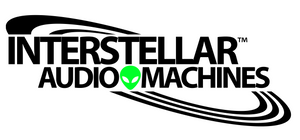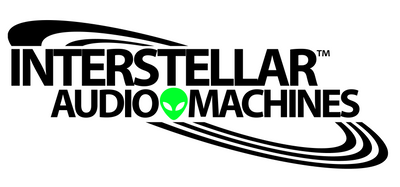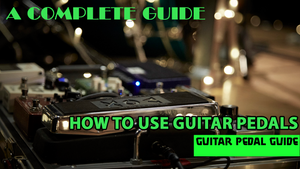As I was digging around to put together this blog, I came across the perfect article that had what we wanted to talk about today. So instead of reinventing the wheel, we are reposting this from Gear4Music Blog written by Matty Newbold.
HOW TO USE GUITAR PEDALS – A COMPLETE GUIDE
Guitar pedals, also called effects pedals or stompboxes, are compact electronic devices designed to modify the sound of a guitar. Every guitarist uses them, and they’re probably a key contributor to your favourite artist’s tone – on top of the amp and the guitar itself.
These units have traditionally been utilised to generate unique effects such as wah-wah, delay, overdrive, and distortion – everything you need to make your sound distinctive.
But how, exactly, do you use them? In this article, we’ll show you how to use guitar pedals and recommend some pedals that may be best suited for your setup.
IN A HURRY?
In just three steps, here’s how to use your guitar pedal:
Power it up! You can either use a 9v battery or use an external power supply and plug it into the mains.
Plug it in! Connect the pedal to your pedal board via a connection jack cable.
Turn it on! Press the button with your foot to turn the pedal on/off.
WHAT DO GUITAR PEDALS DO?
Guitar pedals, whether they’re digital or analog, take the signal produced by a guitar and modify it before passing it on through the chain. This chain might incorporate additional pedals or an amplifier.
In the case of analog pedals, the electrical signal from a guitar is directed through various components such as transistors, resistors, capacitors, and diodes, among others. The specific components utilised depend on the sound that the pedal has been designed to produce.
Alternatively, digital pedals operate by sampling the electrical signal from a guitar and converting it into binary code. An effects algorithm then modifies this code before it is reconverted into an electrical signal and transmitted onwards.
Typically, a guitar pedal will be equipped with at least one input and one output, a source of power, and an on/off switch. You’ll also find a number of control knobs, which vary from pedal to pedal; these allow you to modify and tailor your tone.
There’s an enormous array of foot pedals on the market today, each contributing a unique element to the sound produced by a guitar. This plethora of options ensures that you have a multitude of choices when it comes to enhancing your guitar’s sound, thereby enabling you to create unique and personalised tones.
HOW TO USE GUITAR PEDALS
POWER IT UP!
There are two ways to power up a guitar pedal – the utilisation of a 9-volt battery or connection to an external power supply into the mains.
Powering your guitar pedal via a 9v battery is great for buskers and travelling guitarists, where power can be difficult to access.
A power supply is commonly used on pedal boards, as they can power up multiple pedals simultaneously. Some larger pedal boards may require two power supplies.
PLUGGING IN THE PEDAL
Plugging guitar pedals in is simple. If you’re just using the single pedal you can plug your guitar into the pedal input using a jack cable. Following this, another jack cable is used to connect the pedal to the amplifier. To power the pedal in this manner, the power cable is inserted into the power input on the pedal and then plugged into a power source.
Alternatively, a 9v battery can be utilised to eliminate the requirement for an additional cable.
If you want to set up a pedal board with multiple pedals, things get a little more complicated. You should consider the order of the pedal chain as effects are layered in the arrangement that they are connected. For example, a compression pedal ought to be positioned at the end of the chain to apply compression to the entire loop.
On a pedal board, you should plug the guitar into the first pedal in your chain, then connect or the pedals together using small jack link cables. Power can be supplied to each pedal by incorporating a power supply onto the pedal board or by using 9v batteries.
THE FOUR-CABLE METHOD
If you want to opt for the four-cable method, you will need an amplifier with an effects loop; a basic combo practice amp will not suffice.
The four-cable method extracts the best performance from your pedals by connecting them to your amp’s effects loop. It also allows you to create a custom rig, creating a unique sound that is tailored to the your specific preferences and requirements.
ARRANGING MULTIPLE PEDALS
As we mentioned earlier, if you’re using more than one guitar pedal or building your own pedal board, it’s important to consider the order in which you put them.
Essentially, the effects are added to the original sound of your guitar in the order of your pedals until they reach your amplifier. You can play around with this arrangement in order to achieve the best sound, however, guitarists usually place EQ and compression pedals, for example, at the end of the chain.
If you only have two or three pedals, it’s good practice to experiment with every combination possible. This way, you’ll quickly figure out which order works best for your own preferences.
USING PEDALS WHILE PLAYING
Once you have your pedal or pedalboard connected and arranged in a way that sounds the best for you, you can start looking at how to use them during your performances. There are two ways you can use your guitar pedals: effects-on-demand and always-on.
Effects-on-demand is the most common way of using guitar pedals. This is where you simply turn the pedals on and off during performances, depending on which effects you’d like to hear. Most effects, such as wah, phaser, flanger, and distortion are likely to be used as on-demand effects. This is because it allows you to add the effect for a section of the song, rather than having to have it on for the entire performance.
Always-on pedals are pedals that remain on throughout the entire performance. Pedals such as reverb, eq, delay, and compressor are perfect for this method – providing a level of consistency across your performance.
Other things to consider when using your pedals are the volume and effect level of each pedal. For example, if you’re using compression or volume gain pedals, you should turn down the volume before adding the pedals. This prevents unwanted distortion and ensures maximum clarity in your final tone.
CHOOSING THE RIGHT PEDALS
There are a range of different pedal types on the market, all of which offer a different sound and effect to your overall mix. These include gain, modulation, dynamics, utility, EQ, and time-based.
GAIN
Gain pedals, such as distortion, simply boost the signal to the point that the sound distorts.
The Hartwood Beartooth Distortion pedal is a tribute to the quintessential rock ‘n’ roll tones, echoing some seriously iconic sounds.
It enables you to recreate the edgy, raw, and authentic distortion tones that were the hallmarks of legendary bands and guitar virtuosos from the ’60s and ’70s.
Whether you’re delivering heartfelt bluesy riffs or dialling up the gain for powerful rock anthems, this pedal infuses a hint of nostalgia into your performance.
And whilst it does all of that, it also offers the dependability and
performance that modern guitarists need to meet contemporary musical requirements.
Not heavy enough? The SubZero Forge Metal Distortion Pedal sharpens your performance with high-gain saturation, yielding a robust, aggressive metal tone.
Metal guitarists need highly distorted tones with meticulous articulation for both chugging riffs and rapid runs, and the Forge Metal provides these in ample measure.
MODULATION
Modulation pedals change the variation of a signal over time.
These pedals create a unique effect that’s often featured in the standout riff of a song.
The more common modulation pedals are chorus, tremolo, and phaser – although vibrato and flanger are other examples of modulation pedals.
The Hartwood Collinsvile generates a traditional chorus effect that enhances the depth and richness of your guitar’s sound.
Ranging from subtle, glistening textures to engulfing, swirling tones, this pedal offers a broad spectrum of chorus effects compatible with any musical genre.
Adjust parameters such as speed, depth and volume to tailor the Hartwood Collinsville to your preference.
The SubZero Polar Drift Phaser Micro Guitar Pedal is an ideal addition for any musician performing live. Boasting a high-quality build and a fully analog circuit design, this pedal is not only user-friendly but also delivers excellent sound.
The stomp button facilitates easy activation of the phaser effect or bypassing the pedal using the true bypass function.
DYNAMICS
Dynamic pedals include compressors, limiters, and noise gates.
These pedals affect the processing of volume and are best placed at the end of the pedal chain.
Compression pedals emphasise the tone and thicken the sound of your guitar, whilst maintaining a consistent volume level throughout.
Another way to boost the fullness of your sound is with a looper pedal.
The SubZero Rollercoaster, for example, allows for 30 minutes of looping time, meaning you can create rich textures, become your own accompaniment, and produce new soundscapes.
There are three independent loops and infinite overdubbing
capabilities. Plus, thanks to a simple, intuitive design – with a knob,
switch, and button – it’s easy to use, whilst the side-mounted USB port lets you upload and download loops.
UTILITY
Utility pedals don’t add any effect to your sound but add a great deal of convenience to your playing. They include things like tuning pedals, switcher pedals, and expression pedals.
The Subzero Ultrawide Guitar and Bass Pedal Tuner offers an extremely accurate reading displayed on a large, bright screen. It assures optimal sound quality at all times.
Regardless of whether you prefer a standard tuning or extreme drop tuning, the tuner’s adjustable frequency/pitch setting ensures it can accommodate any tuning style.
EQ
An EQ pedal allows you to manipulate the tone of your guitar to accommodate any production or performance.
100Hz – Lower this band to get rid of any unwanted low-frequency content. This, in turn, creates room in the arrangement for the kick and bass to be more noticeable.
250Hz – A slight increase in this band can instil “body” into your sound, which is particularly useful if you’ve implemented a drastic cut elsewhere. This smooths out your low-end, leading to a more natural and defined sound.
630Hz – Implement a moderate reduction of approximately 2-3dB to tackle the “mud” and “boxiness” of distorted guitars.
1.6kHz – Experiencing difficulty in cutting through and being heard? A
mid-range boost at 1.6 kHz can solve this issue. This enhances the “bite” of your tone by emphasising transient details such as pick attack. Conversely, if your tone is excessively “aggressive”, you can reduce this band for a more natural balance.
4kHz – A boost here can provide your sound with added definition. In particular, a boost of 1-2dB in this region can instantly deliver that “record-ready” sound.
The SubZero Hidden Gem Guitar EQ Pedal is a no-compromise solution for tweaking your tone. Engineered in- house by the specialists at Gear4music, the core of the pedal houses five fixed frequency bands. These have been deliberately selected to align with frequencies prominent in electric and electro-acoustic guitars.
TIME-BASED
Time-based pedals, such as reverb and delay pedals, work by multiplying the guitar signal.
Reverb pedals are a great way to add warmth to your sound, and they usually allow you to choose the type of reverb you require.
The SubZero Space And Time Digital Reverb Pedal comes packed with a variety of unique soundscapes to enhance your tone. From subtle depth to tones that are out of this world, this pedal has it all covered. It features three distinct modes: Room, Spring, and Shimmer. Each mode is selected for its distinctive reverb tone.
Room – As the most natural among the three, Room imparts the
inherent vibrance and colour of an untreated room. This is ideal when
you’re looking to introduce a slight dimension to your tone. Brief and
impactful, this effect is excellent for ensuring your rhythm guitars blend
well within the mix. Manipulate the Tone knob to transform this from a subtle element to a crucial part of your sound.
Spring – This mode faithfully reproduces the iconic sound associated with American amplifiers of the 1960s. The original sound was created by directing a signal into coiled steel strings to emulate reflections. Warm, dark, and rich, this type of reverb is unmistakable, especially on transient-heavy material such as picked bass and simple melodic riffs. Its popularity among contemporary pop and indie artists is a testament to its effectiveness.
Shimmer – This style of reverb, which first came about in the late ‘80s, is a cornerstone effect in ambient and post- rock music. Shimmer is produced by overlaying a reverb tail, which is then pitched up an octave and processed through a feedback loop, atop the dry signal.
Delay pedals provide an echo-like effect by repeating the sound. These pedals typically incorporate parameters such as duration, feedback, and intensity.
Duration – The duration parameter enables you to specify the precise interval before the signal repeats. When set at “1”, the pedal will generate a delay of 50 milliseconds; when adjusted to “10”, it will produce a delay of 400 milliseconds.
Feedback – By modifying the feedback control, you can influence the duration of the delay. This sets the period for which the effect will repeat prior to fading away. A setting of “1” results in a slapback sound, while a setting of 10 gives you a prolonged delay.
Effect Intensity – This control allows you to alter the output volume when the pedal is activated.
The SubZero Public Transport Delay Pedal is a digital delay that can create a wide array of sounds, made possible by the acclaimed PT2399 delay chip.
This pedal is capable of producing everything from the subtle slap-back effect common in rockabilly music to the massive swells found in post-rock, and even more. By tweaking the Duration control, you can move from gentle ambience trails to extended, echo-like repetitions, all the while adding a unique layer of depth to your tone.
FAQS
DO I PLUG MY GUITAR INTO THE PEDAL?
Yes, your guitar plugs into the input of the guitar pedal. The output then plugs into the next pedal in line or straight into an amp.
WHAT ORDER DO I PUT MY PEDALS IN?
The order of your guitar pedals is up to you. It’s a good idea to play around with the order to find the tone that best suits you. It’s common practice to have any dynamics, EQ, gain, or utility pedals towards the end of the chain, though.
HOW DO I PLAY GUITAR WITH PEDALS?
Once the pedals are set up, the playing is the exact same as it is with just an amp. You can add effects whenever you like by stomping on the pedals.
FINAL THOUGHTS
Now that you have a better understanding of how to use guitar pedals, why not check out our full range? Thank you to Music4Gear Blog and Matty Newbold for the great tips
Come along the ride into the Interstellar universe of guitar pedals. Keep an eye out for what we are working on next!


